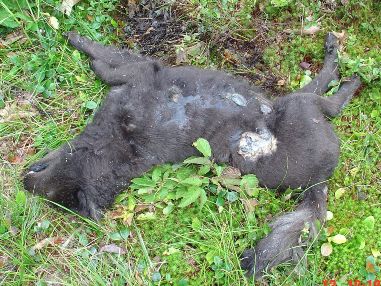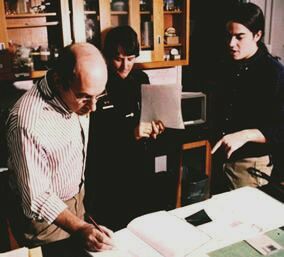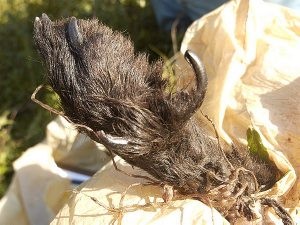
August 26, 2006
Click on image for full-size version
Photograph by Michelle O’Donnell. Used by permission.
The body of the dead animal found in Turner, Maine, according to DNA tests conducted on behalf of and paid for by the Lewiston newspaper, the Sun Journal, belonged to a member of the genus Canis, not a Tasmanian devil, not a rodent, not a Chupacabras, not a hyena, not a werewolf, not an Eastern Bigfoot, and/or not from any wild species speculations that were heard over the last ten days. Nevertheless, it is important to understand, the real Mystery Beast is still out there!
Readers of the print newspaper (front page, above the fold) and the online edition (requires subscription) will find more details in the Saturday, August 26, 2006, issue of the Lewiston Sun Journal. Reporter Mark LaFlamme’s article “‘Creature’ Looks Like A Canine,” discusses what the Sun Journal discovered through the tests run on the paw and parts of the limb that I took off the carcass and handled over to the newspaper. I will summarize (in italics) his article, in the Sun Journal’s first revealing of the DNA results.
Click on image for full-size version
Photograph by Michelle O’Donnell. Used by permission.
Investigative journalist and a regular on the crime beat desk, Mark LaFlamme writes:
Turner – If the Maine woods are haunted by a creature of unknown species, that beast remains out there alive and running wild.
A dead animal found last week in Turner was stripped of its “mystery creature” title after results of DNA tests Friday revealed that the carcass was that of a dog.
A boy dog, to be precise. Early results of the testing at the University of Maine molecular forensics lab showed that the controversial animal had a dog for a mother and most likely a canine father as well. “Not surprisingly, it has all the indicators to link it to being from Canis, a dog,” said Dr. Irv Kornfield of the UMaine lab. “We only have a signature of who the mother of this animal is. We do not know who the father is. We can make no assertions about who fathered this animal. Parenthetically, the animal is male.”

Pictured on the left, Professor of Zoology Irv Kornfield directs the Molecular Forensics Laboratory at the University of Maine, located in Orono. His lab supports forensics investigations by Maine law enforcement and wildlife agencies throughout the state. Photograph: Courtesy UM.
Kornfield and another forensics specialist from Toronto agree that the animal that drew media attention from around the world has the basic foundation of dog DNA. However, both said more testing would need to be done to determine if the dead animal had genetic material from wolf or any other species.
The results were obtained Friday after the Sun Journal sent tissue from the dead animal last week. The newspaper wanted DNA testing done to settle a debate that raged through Maine and other parts of the country: was the dead animal a mere dog or some exotic species that did not belong here?…Dr. Yuri Melekhovets at HealthGene Corp. in Toronto plans to run more tests, the odds of finding anything exotic in the DNA mix seemed remote.
In one of those quirks of fate, although I’m known around the world for my cryptozoology work, via my books and Cryptomundo, I happen to live in Maine. The reporter sought me out for my opinion of what the body could be early on in this drama. Mark LaFlamme and I cooperated throughout the course of this investigation, in a free exchange of information and discussions about the event and the probable results. On Friday, August 26th, we talked again, and LaFlamme included part of our conversation, with permission, in his article:
“I’m not startled or shocked by this news, and have tried to prepare the principals involved in this from the beginning,” said Maine cryptozoologist Loren Coleman. “I thought there was a dog in the mix here, and that is visually what I saw and the verdict I was expecting.”

The untrimmed dew claws of the animal killed by a car, and discovered alongside Route 4, Turner, Maine. Sun Journal photograph by Douglas Van Reeth. Used by permission.
The Sun Journal role was pivotal in finding a concise answer to the “dead body” question, while I concurrently told the story here at Cryptomundo. LaFlamme writes:
The once mysterious animal was found dead Aug. 12 in the backyard of Debi Bodwell. Her neighbor, Michelle O’Donnell took photos of the carcass before it began to decompose. O’Donnell, who saw the animal alive a week before it was struck by a car and killed, insisted from the start that the creature did not look like a dog. Her photographs, obtained by the Sun Journal, eventually appeared on television news broadcasts, cryptozoology Web sites, and news pages around the country.
Please click on image for full-size version
Photograph by Michelle O’Donnell. Used by permission.
LaFlamme continued later in the article:
One part of the mystery that remains is the exact breed of dog that caused the uproar. Kornfield said the profile of the DNA is common to many American Kennel Club recognized breeds. However, he was unable to determine if the dog was a Chow, as many suspected, a German Shepherd or some other breed. “The sample was really degraded,” Kornfield said. “We were lucky.”
The Sun Journal captured the flavor of the historical and yet continuing mystery that was not solved with this body, at the end of the article:
For more than a week, many people clung to the belief that the animal would ultimately prove to be the mystery creature that has hounded the area for more than a decade. For years, consistent reports have arisen of an unidentified animal with glowing eyes, a chilling cry and the features of a wolverine, a hyena and a Tasmanian Devil.
The mystery beast has been blamed for killing a Doberman Pinscher in Wales and mauling a Rottweiler in Greene. It has also been suggested as the cause of missing cats around the region.
Since the turn of the century, the Sun Journal has carried stories about strange creatures emerging from the woods. In 1906, a brief story appeared about a mystery creature then known as “the Injun Devil,” a “strange, dun brown thing with lolling chops and tasseled ears” that roamed the woods of West Gardiner, scaring berry pickers. The creature was also known as the “Lucifee,” or “Indian Devil.”
Two years ago, 72-year-old Leo Doyon was sitting on his deck outside his Perkins Ridge Road home in Auburn when a strange animal came up over the bank. Doyon, who has been hunting the Maine woods for 50 years, said the beast was like nothing he had seen before. “I said, ‘what the hell is this?’ It was no wolf. It sure as hell wasn’t a fisher and it wasn’t a coy dog,” Doyon said at the time. “To tell you the truth, I don’t know what it was.”
Coleman, the cryptozoologist, does not believe the animal found in Turner is connected to earlier sightings of Maine’s true mystery beast. Like others, he believes that in this case, a lot of people simply wanted to believe it was.
“Sometimes people are so emotionally involved in trying to ‘solve’ the mystery, there’s a rush to explain the bigger picture with what I call random coincidental events,” Coleman said. “I think there still is a mystery beast out there in the woods around Turner.”
Mark LaFlamme’s Sun Journal article is balanced, clear, and covers the explained and the unexplained. It will be interesting to see if the wire services and other media boil this all down to “Maine Mystery Beast = It’s A Dog” or “Real Mystery Beast = It’s Still Out There.”
About Loren Coleman
Loren Coleman is one of the world’s leading cryptozoologists, some say “the” leading living cryptozoologist. Certainly, he is acknowledged as the current living American researcher and writer who has most popularized cryptozoology in the late 20th and early 21st centuries.
Starting his fieldwork and investigations in 1960, after traveling and trekking extensively in pursuit of cryptozoological mysteries, Coleman began writing to share his experiences in 1969. An honorary member of Ivan T. Sanderson’s Society for the Investigation of the Unexplained in the 1970s, Coleman has been bestowed with similar honorary memberships of the North Idaho College Cryptozoology Club in 1983, and in subsequent years, that of the British Columbia Scientific Cryptozoology Club, CryptoSafari International, and other international organizations. He was also a Life Member and Benefactor of the International Society of Cryptozoology (now-defunct).
Loren Coleman’s daily blog, as a member of the Cryptomundo Team, served as an ongoing avenue of communication for the ever-growing body of cryptozoo news from 2005 through 2013. He returned as an infrequent contributor beginning Halloween week of 2015.
Coleman is the founder in 2003, and current director of the International Cryptozoology Museum in Portland, Maine.
Filed under Artifacts, Breaking News, Cryptotourism, CryptoZoo News, Cryptozoologists, Cryptozoology, Folklore, Forensic Science, Media Appearances, Pop Culture, Swamp Monsters